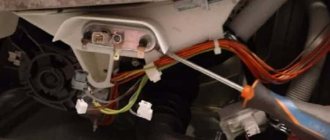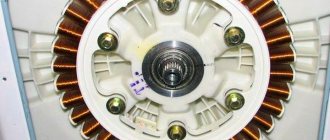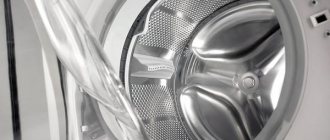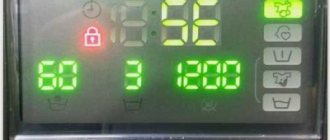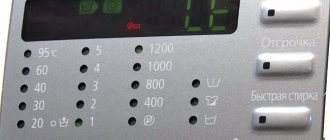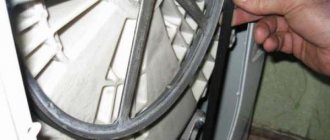Each apartment has a lot of different household appliances, so the owners try to monitor the quality operation of all appliances. When any strange sounds appear during operation, this should alert you. Such situations are especially typical for washing machines; this cannot be ignored. And there are plenty of reasons for this - incorrect installation, violation of the operating instructions, etc. But knocking is a general understanding. You can hear grinding, rustling and other signs.
So, sometimes the drum in the washing machine knocks. For this reason, you will have to pay close attention to all noise. And the very first thing that is required from the owner is to stop the working cycle and turn off the water supply. It is drained, the laundry is removed and the solution to the problem begins.
Where should you start?
When the drum in the washing machine knocks loudly, the cycle is stopped and the cause of what is happening is identified. And here it is important to pay attention, if it is new, then the problem is as follows:
- Forgot to remove the shipping bolts.
- Wrong choice of installation location.
- The plane of the floor is broken.
When problems do not arise in this direction, then it is worth looking at how the laundry is filled. There are special recommendations and weight standards. When this is violated, then during spinning the rotation of the drum is maximum and an imbalance occurs. This is what leads to such sounds. Sometimes any items that are not removed from the pockets before washing cause noise. To do this, you need to rotate the drum by hand and listen carefully.
These are situations in which each person can figure it out on his own without a master. But could the drum in the washing machine be knocking for other reasons? Yes, they may be present, but in such a situation you cannot do without a competent master. When small sounds begin to appear, they cannot be ignored. Otherwise it will be a big problem and serious damage.
Another option is to find certain signs characteristic of certain breakdowns. If the drum in the washing machine is knocking, and after removing the laundry, rust is visible, these are worn out bearings and deformed rubber bands or seals. The appearance of water under the unit is also a cause for concern. You can check the integrity of the bearings - you need to try to turn the drum by hand. If it doesn't work out, there can be no doubt. Bearings to be replaced.
It makes a lot of noise - is this a breakdown or normal?
During operation of the device, noise may sometimes even be a normal situation. Some sounds that Indesit makes are not a sign of failure.
Such situations include noise during the following processes:
- water inlet;
- pump operation;
- heating water;
- rotation of the drum during the spin process;
- clattering transition to a new stage of the washing program.
You should start to worry when the car suddenly starts making strange sounds that are not typical for it. Most often, they make themselves felt precisely when the drum is actively rotating and under high load. If there is noise in the device, it is important to correctly determine its cause.
In some cases, such a sign is not a breakdown. Each device has a maximum permissible noise value .
This indicator is indicated in the documents for the machine. Typically this is between 60 dB and 72 dB. If during operation the noise level is within the limits specified by the manufacturer, this is not a malfunction, but corresponds to normal operation.
What's wrong with the underwear?
Often the washing machine drum knocks when rotating. This is typical for older models. This especially begins to happen when the laundry is collected in one lump (imbalance). Because the cylinder begins to knock in one direction and this gives strange sounds, grinding, etc. But not every cycle will be done this way. There are obvious situations:
- Lots of small things.
- Bed sheets.
- Loading weights that are not permitted according to the instructions.
To eliminate the knocking, the cycle is stopped, the drum is opened and things are laid out or unnecessary items are removed. To prevent this from happening in the future, you should adhere to the operating rules and load small laundry halfway with large laundry. Today, manufacturers take this error into account and create new models of the unit with a stacking control system. Therefore, when purchasing, you can already get rid of the occurrence of such a problem in the future.
In addition, laundry can be the simplest reason why the drum in the washing machine knocks when washing. Namely, items left in pockets, as well as buttons, straps and fasteners. They are capable of breaking away and getting into any gaps. And children in the family can do interesting things by stuffing small things into the drum or powder tray itself. This is a serious issue because such items get into the drum and it breaks down. If you manually spin the drum, it is easy to understand that there is something inside.
You can remove these elements yourself, using a small wire, placing it in the cracks. But the simplest method is removal through the installation holes of the heater (heater). It is worth doing some minor disassembly and only then removing the items. When everything is returned to its place, you need to install a new seal and lubricate it.
Prevention measures
In order not to encounter the problem of noise during the spinning process of the Indesit washing machine, you need to remember the following preventive measures:
- When stowing items, be sure to check the pockets of items and not stow underwear with poorly sewn buttons, decor, etc.
- The search for the source of the problem should begin with simple nodes, gradually moving to complex ones.
- If extraneous sounds appear in the “spin” mode, it is necessary to organize diagnostics and establish the cause of the problem.
- It is advisable to start the machine with optimal load of laundry. It is better to avoid overloading and underloading.
- The service life of a household appliance without breakdowns largely depends on the correct installation and connection of communications.
You should not even partially open the washing machine if the device is under warranty.
A lot of important and useful information about repairing Indesit washing machines is presented in this section.
Incorrect installation
The drum in the washing machine knocks during the spin cycle due to non-compliance with operating instructions. Often the owners, after installing the unit, are in a hurry and do not level it, and also forget to remove the shipping bolts. It is at high speeds that this becomes apparent. And the task of the bolts is to hold the drum back, so an unusual sound will be heard.
Installation must take place on a solid base; some cast it from concrete. In addition, it is worth adjusting the legs. This is true in cases where the floor surface is already finished with tiles or something else. So in such a situation, it is worth correcting the situation, and the operation of the machine will return to normal. To check whether everything is done correctly, you need to try to rock the device with your hands. If there is no movement, everything is done correctly. The machine should not shake.
There is a foreign object in the tank
A knocking sound in the drum of a washing machine from the Indesit company may appear from the presence of a foreign object inside the unit that is in the tank. This problem is considered more serious than previous cases because the system can suddenly jam. To get rid of the cause of the knocking, you should turn off the washing machine and disassemble it.
After disconnecting the washing machine from the electrical network, try to remove the foreign object using the hole near the water heater. The algorithm of actions is as follows:
- the Indesit washing machine is disconnected from all communication systems;
- the unit is installed in the center of the room to provide easy access to the rear panel of the machine;
- Unscrew the screws and remove the back cover of the case;
- disconnect the contacts of the water heating element;
- remove the nut holding the heating element;
- holding the heating element, carefully rock it, gradually removing it from its seat.
Drum pulley
If nuts or bolts become loose over time, vibration occurs. When a part is restored, the attachment point is additionally sealed with sealant.
These are the simplest breakdowns. The rest lead to expensive repairs, although some purchase a new machine. Because to restore functionality, the technician has to disassemble the entire machine. To answer the question why the drum is knocking in the washing machine, you need to work through each option.
Spring breakage
If the spring breaks, the drum may tilt to one side. However, it can look exactly the same if the shock absorber breaks down. To accurately identify the cause, it is necessary to disassemble the machine. This is done at the service center, and if there is a faulty spring, it is replaced. If you ignore the problem, then when washing the drum will poorly center the laundry and constantly sway.
A broken shock absorber has very similar symptoms to a broken spring:
- the drum “sags” to one side;
- The washing machine cannot center the laundry correctly;
- there is a permanent imbalance.
In addition to the shock absorber, the mount may break, or the mounting bolt may simply become loose. It is possible to determine why the extraneous sound occurs only after disassembly. It is recommended to first carry out diagnostics by calling a specialist. After identifying a malfunction, the shock absorbers are replaced with new ones.
Useful arguments from experts
In the professional work of washing machine repairmen, questions often arise to which they do not always know the answers. Because the reasons can be common and unexpected, depending on the model of the unit. Therefore, you need to know what to do if the washing machine drum is knocking. The division is based on models characteristic of their work:
- “Veko” - this model is known to many. What does it mean if the drum starts making a knocking sound during the spin cycle? To fix the problem, you need to replace the bearings, but at the same time install new seals. You can also view the cross shaft.
- "Atlant". Increased knocking and vibration may occur during operation. The problem is eliminated when the unit is installed level and according to the instructions.
- "Ariston". Complaints about knocking and vibration. After replacing the seals and bearings, the problem did not go away. As a result, it was necessary to change the shaft.
- "Samsung". After a long period of operation, vibrations began and a grinding noise appeared. After another job, a heap of substance comparable to cement and dust fell out from below. This is a breakdown of the heating element. In addition, such processes can lead to failure of the motor itself.
- LG – often suffers from squeaking. This happens when any small particles get caught between the drum and the side of the machine.
Some models have their own breakdowns. But this is optional. They also have a shelf life without repair (again, this is all on an individual basis). The only point that applies to each model is that if any knocking or grinding noise occurs, you cannot end the cycle and not pay attention to it. Otherwise, you will have to invest a lot of money on repairs.
Why does the washing machine make noise when washing and spinning?
There are many reasons for the appearance of extraneous noise, and they are not always associated with a breakdown. To begin with, it is important to distinguish whether the unit knocks only during spinning or in any operating mode. Let's look at the most common simple causes of knocking.
Wrong load of laundry
The problem is especially typical for older models of washing machines, which cannot determine whether there is an imbalance or crumpled items in the drum. Spinning is carried out in any case, and the drum knocks on the walls of the machine. If the knocking problem occurs occasionally, you may simply be overloading the equipment or unevenly distributing the laundry in the drum.
The equipment is not installed correctly
If the installation is carried out incorrectly, the washing machine begins to vibrate and knock heavily during the spin cycle. In the future, this can lead to serious equipment breakdown, so this problem cannot be ignored. The machine must be installed on a flat surface; the position of the legs is adjusted using a level locking nut.
Important! If the washer not only knocks at high speeds, but also sways and vibrates strongly, this indicates errors in the installation.
There was a foreign object inside
Often the cause of extraneous noise and knocking is small objects that get into the drum along with clothes - coins, torn buttons, paper clips, screws. When rotating, the machine creates a centrifugal force, under the influence of which objects can fall inside the housing - through holes in the drum or under the sealing collar.
Violation of support
The washing machine operates smoothly and silently only when placed on a flat surface. Perhaps the machine is rattling because it has moved off the platform, the balance has been disturbed, and this leads to the fact that it rattles both during washing and spinning.
Transport bolts
If a new machine is knocking, the first thing you need to do is check whether the shipping bolts have been removed before installation. Sometimes people forget about them, which is why the machine starts to rattle - the tank is fixed, the shock absorbers and bearings do not dampen vibration.
The cause of the knocking may also be more complex problems associated with the breakdown of individual parts of the automatic machine.
To diagnose and identify the malfunction, invite a specialist to your home. It is not recommended to disassemble household appliances yourself.
Here are the main breakdowns that can cause additional noise and knocking.
Broken spring or shock absorber
This can be seen visually by removing the back cover and checking the fastening. The same thing can be connected with the counterweight. With such a breakdown, the shock absorbers rattle loudly during spin cycles. This usually happens as a result of prolonged active use of the equipment.
If the problem is not corrected, the drum will constantly sway and distribute the laundry poorly, which will make it worse to wash.
Bearing wear
Bearings are responsible for the smooth, silent rotation of the drum. They usually last at least 5-6 years, but sometimes bearings can fail earlier. In this case, the washing machine drum makes a particularly loud noise during the spin cycle, and also when the engine picks up speed. If there is severe wear, the problem may become more complicated because the machine will stop spinning clothes altogether. The bearings need to be changed as soon as the knocking is noticed and the technician has identified the cause.
The counterweight has come loose
To weight and balance the tank, a counterweight is installed in the automatic machine. The weighting material can be cast iron, concrete or monolithic plastic. This design reduces the risk of rocking during the wash cycle.
Over time, vibration can cause the counterweight to become loose or even completely fall apart. Then the machine begins to bounce a lot during operation and knock during the spin cycle, since at high speeds the drum touches the walls of the equipment.
Problems with the surge protector
The surge protector is located in the upper part of the rear casing of the washing machine and is responsible for leveling out power surges in the network. Sometimes the fasteners holding it in place become unscrewed or break.
The filter then hangs on the wires, and during the spin cycle, when the vibration increases, it begins to sway violently. When the compensator hits the housing or tank, it makes loud knocks. If it is not fastened in time, the surge protector may cause a short circuit and failure of the washing machine's electrical system.
A common problem is bearings.
Oddly enough, it is the bearings that quickly fail. This is indicated by grinding and knocking at high speeds or the appearance of any new sound. This is normal wear and tear, especially for those who use the machine frequently. The longest shelf life for such a part is 5 years; you can simply check its suitability by twirling the drum with your hands.
And if the drum knocks when the washing machine picks up speed, then this is a sign of bearing wear. Today it is not so easy to find this component. Repair involves disassembling the machine in the bottom area. But the procedure itself is not as easy as it might seem. You must not disturb anything during the process, otherwise more expensive repairs will be required.
Although many who know how to use tools cope with this task themselves. But if you have no experience, then it is better to go to a master. Because a person without experience may be mistaken in his assumptions and simply disassemble the unit in vain. Shock absorbers and springs fail no less often and must be replaced. The procedure is carried out in several stages, but if something is done wrong, the drum will fail and half of the machine will have to be replaced. Because the drum is skewed, but it cannot work like that.
Sometimes, after replacing a part, it fails again after some time. Therefore, you should not assume that the master is not doing his job fully.
Reasons why the drum in the washing machine knocks
The drum can knock due to various factors; the appearance of a defect can be affected by the forgetfulness of the owners or wear of parts. Among the main reasons:
- Incorrect installation. If you do not park the machine level after purchase, a loud noise will be heard when the cycle starts. In addition, during the spin phase the appliance may begin to move.
- Bearing wear. Signs of a problem are wet laundry, even after an intensive spin cycle. This problem occurs on old devices that have been in use for about 10 years.
- Loose counterweight mount. Modern tanks are made of plastic, so they are quite lightweight. Due to its light weight, it begins to vibrate when the drum rotates. The counterweight is designed to block vibrations. Cement is usually used for production.
- Shock absorbers malfunction. The part serves to reduce vibrations when the drum moves. Usually occurs after prolonged use.
- Object stuck between drum and tank. The problem usually occurs when cycling at high speeds. Small objects can cause problems, not just trash left in your pockets. For example, a children's sock or an iron wire from a bra.
- The network filter is faulty. It protects against power surges. Usually the part simply unscrews due to constant vibration when the drum rotates.
- Imbalance of laundry inside the drum. If the load is overloaded or, conversely, underweight, the laundry begins to bunch up. As a result, the drum will begin to knock during washing.
Why does the drum shake?
The bearings are damaged.
The shock absorbers are broken.
The crosspiece is cracked.
A foreign object is stuck in the tank.
These reasons cause increased play in the machine.
To correctly diagnose the problem, pay attention to the characteristics of the looseness, the size of the gap
Causes of malfunction
Before immediately taking your equipment for repair or calling technicians to your home, you can conduct initial diagnostics yourself. There is a high probability that you will determine the cause yourself, while saving some money that you would have to pay to the adjusters.
The most common causes of noise:
- there is something foreign, a small object, a part between the body and the drum;
- the rotating bearings are badly worn;
- bolts for transporting the tank are loose;
- the axis of rotation of the centrifuge has broken, or its fastening has become loose;
- problems with the counterweight: poorly secured or needs to be replaced.
When is knocking normal?
If the sounds that a Bosch washing machine makes are different from what you are used to, you need to try to identify them. It happens that knocking from the drum is a normal situation.
Accessories on clothes
The sound of metal on metal can be made by clothing with metal buttons and rivets . When, during spinning or washing, accessories from clothes hit the glass of the hatch or the drum, a clanging sound is possible.
To prevent scratches on the surfaces of your Bosch washing machine, it is recommended to turn such items inside out before placing them in the drum.
Another method to solve the problem is to use laundry bags. This will eliminate the annoying “clicking” sound and protect the drum from scratches.
Fixing the hose
If the drain hose is not secured well enough, it may knock on nearby objects and on the tank too. The solution to the problem is to remove the contact between the tank and the hose.
The problem with the hose knocking on the tank may in some cases not be felt when running an empty drum.
Incorrect installation of the Bosch washing machine
During the spin cycle, the Bosch washing machine works very intensively, as the drum rotates at high speeds. If the washing machine was installed incorrectly - unstable, too close to other furniture - then knocking may occur.
The solution to the problem is to install the washing machine on a level, stable, so that there is free space between its body and other objects.
Shock absorber failure
A broken shock absorber has very similar symptoms to a broken spring:
- the drum “sags” to one side;
- The washing machine cannot center the laundry correctly;
- there is a permanent imbalance.
In addition to the shock absorber, the mount may break, or the mounting bolt may simply become loose. It is possible to determine why the extraneous sound occurs only after disassembly. It is recommended to first carry out diagnostics by calling a specialist. After identifying a malfunction, the shock absorbers are replaced with new ones.
Other troubleshooting options
Have you decided what the problem is for the normal functioning of a machine that makes noise during the spin cycle? Re-inspect. What other symptoms did you see? After all, it is not only noise that indicates a failed part of the device. Start looking for additional reasons by looking at recently machine-washed clothes to see if there are stains on the items after washing or if you might notice anything else unusual.
If there are noticeable stains on freshly washed clothes, it is worth thinking about the reasons and possible speedy repairs. Second symptom: the holes are closed (machine lid, filter), but there is dripping from below. Water should not flow from a closed machine. If this happens, a clogged oil seal is to blame. When the drum breaks down noticeably prevents it from spinning, this is a sign that again points to the bearings, the washing function is impaired.
